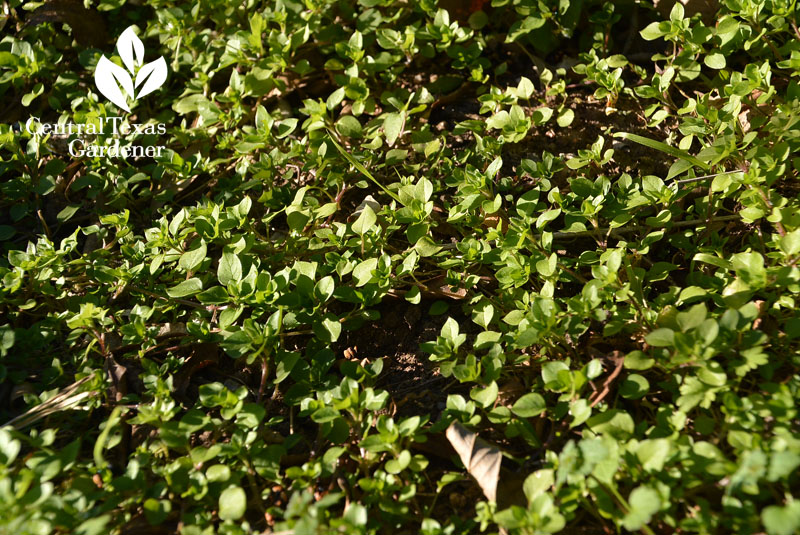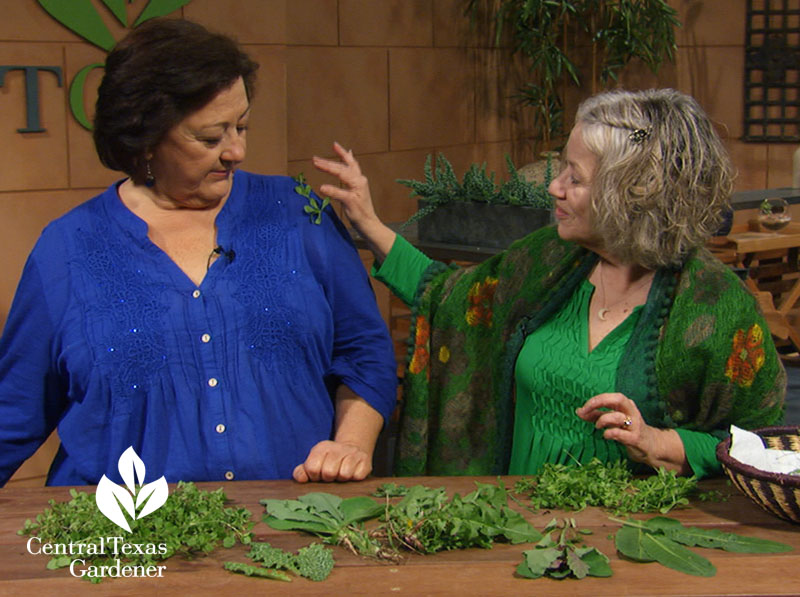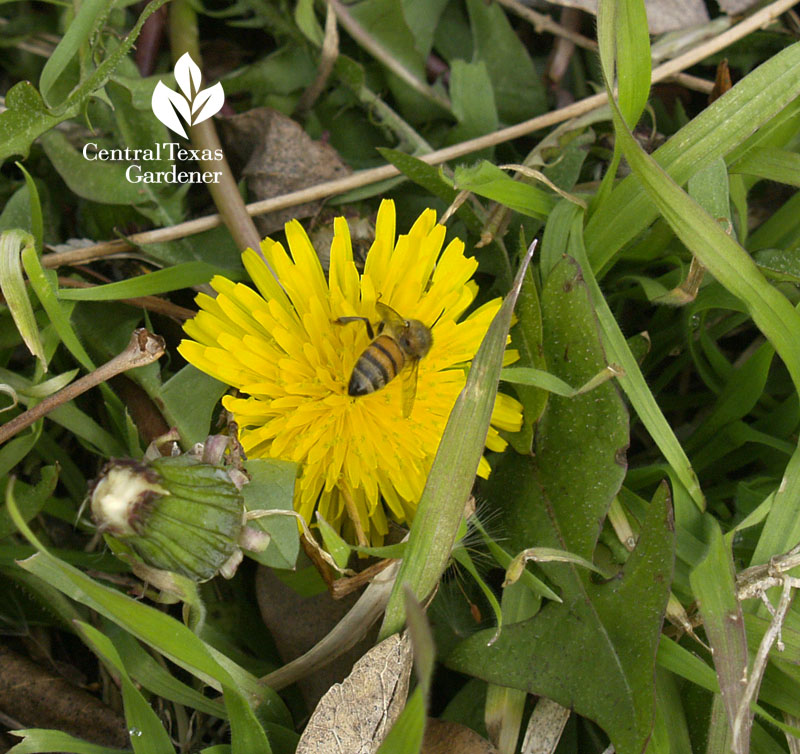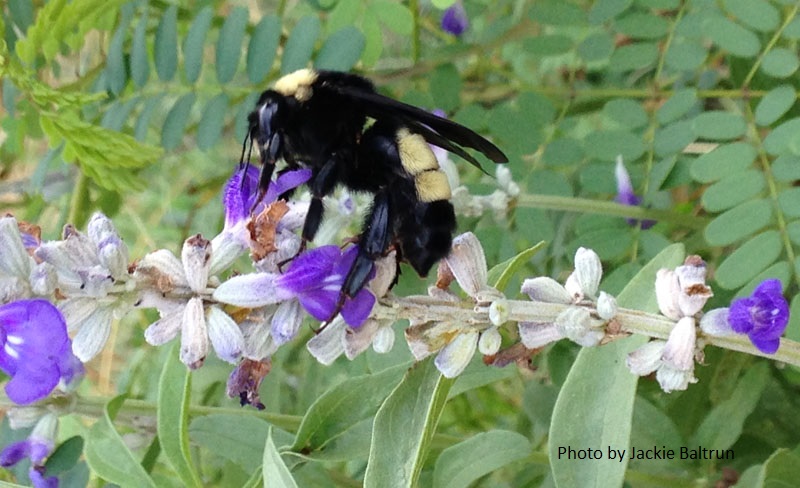February 11, 2016
Hummingbird Haven, Weeds, Courtyard Design
Do you feel like the “other shoe is about to drop?” That’s how I feel right now as rock and roll temps have us stymied about when to prune. Normally, my ‘Grapes’ gomphrena (G. decumbens) would be recumbent by now. Instead, it’s just flopping over in little balls of brightness.

I’ve already cut back many of the turk’s caps, but I can’t bear to touch this one. . . yet!

As dry as it is, “weeds” are growing like weeds! Edible chickweed really covers the ground quite nicely.

Cleavers (Galium aparine) are very clever about ingratiating themselves—here with self-sown larkspurs in my frogfruit strip.

Certified Herbalist Ellen Zimmermann joins Trisha to explain how so-called “weeds” can be good for us. Ellen tells us how cleavers clean out the blood in the lymph system.

Many of us get confused about sow thistle (on the left) and dandelion. Dandelion leaves are beneficial—even great in smoothies!

I never pull dandelions, since their deep taproot brings nutrients to the surface. Most important in my household: indoor bunnies Harvey & Bun do binkies for dandelion leaves! Bees and other pollinators do their version of “binky” on the flowers.

Over centuries, milk thistle has been valued for its medicinal properties. I treasure mine for its variegated foliage and late spring’s puffball flowers that nurture pollinators.

Find out more right now!

And, be sure to check out Ellen’s Austin School of Herbal Studies to learn about medicinal and health-heightening plants.

Meet Ellen and other renowned herbalists at the 1st Annual Heart of Texas Herb Symposium on April 23 in Wimberley.
Now, what do you do when your new house comes with a chinaberry tree? That’s what happened to Robyn Squyres. Sure, birds love the yellow fruits, but Robyn knows that it’s an invasive species that threatens diverse habitats. Already, she’s pulled up seedlings. Also, this tree is very toxic to dogs.

So, should she cut it down now and sacrifice shade or plant a replacement tree underneath to get established first? Daphne responds: Cut it down now! Here’s why.
Get the list of Texas invasive plants.
When felling a tree means lots of new sunlight, native perennial coralbean (Erythrina herbacea) is your ticket to hummingbird haven.

Evergreen in warm winters, its flame-like flower torches emerge in spring and last for months. If extended freezes brown it, simply cut to the ground, as you do any dormant perennial. Find out more about Daphne’s Plant of the Week.

This week, create a hummingbird flight path to your garden with Mark Klym, coordinator of the Texas Wildscapes program at Texas Parks and Wildlife and the Texas Hummingbird Roundup.

In Hummingbirds of Texas, see how to create a habitat, including preferred flowers, colors, and nesting trees. Find out why your visitors stage hummingbird wars! And to identify these fleet-of-wing birds, pictures, drawings, and migration patterns make it much easier.

Viewer Picture goes to Jackie Baltrun for her outstanding shot of a bumble bee on mealy blue sage. Hummingbirds love this plant, too! But deer avoid it, which makes it a great plant for Jackie in her deerly beloved neighborhood!

On tour, when designer Amy Voorhes and husband Selwyn Notelovitz traded Boston for Austin, she swapped months of snow for drought.

To update the courtyard of their 1950s home, she banished overgrown and rather forlorn invasives for raised beds filled with fragrant and flowering plants.

Betsy Clemmons from Dig Austin handled the installation, including concrete underneath to support the weight. Decomposed granite flooring packs down for easy mobility to savor and tend the water thrifty plants that abound after just one year.

Bidding farewell to former plant loves, she adopted water thrifty plants for wildlife, most of them evergreen. The courtyard’s become a favorite living room to entertain.

To elegantly promote the vertical plane, she planted steel trellises with star jasmine and crossvine, leaving room between them and the wall for easy maintenance and to catch runoff.

Even from indoors, she and Selwyn watch the wildlife that call on them.

Amy tucked an inexpensive recirculating fountain into a wall niche.

“I designed it for, not just how it would look, you know, that’s what people think of first with a garden, is bloom, but also for fragrance and for sound. There’s always something that is going to touch your senses when you’re walking through this space,” she told us.
She designed a scrim to pick up the edgy, mid-century lines of the house, and bring the geometry of the house right out into this central courtyard space.

“This is our primary entrance, we’re walking by this garden multiple times a day, and you want it to be beautiful,” she says.


See the whole story now!
Thanks for stopping by! See you next week.
tags:

